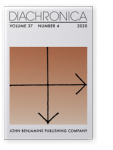Tore Nesset
List of John Benjamins publications for which Tore Nesset plays a role.
2020 A long birth: The development of gender-specific paucal constructions in Russian Diachronica 37:4, pp. 514–539 | Article
This article investigates the diachronic development of Russian numeral constructions consisting of a paucal numeral (dva “two”, tri “three”, četyre “four”) followed by an adjective and a noun. Based on statistical analysis of more than 6,000 corpus examples, it is shown that a split took place… read more
2019 Compounds and culture: Conceptual blending in Norwegian and Russian Corpus Approaches to Language, Thought and Communication, Lu, Wei-lun, Naděžda Kudrnáčová and Laura A. Janda (eds.), pp. 257–274 | Article
This study explores compounds from the perspective of conceptual blending (conceptual integration), and argues that the meaning of compounds arises through the interaction of three levels: (i) input spaces established for the head and non-head components, (ii) a blended space involving… read more
2018 Chapter 6. A constructicon for Russian: Filling in the gaps Constructicography: Constructicon development across languages, Lyngfelt, Benjamin, Lars Borin, Kyoko Ohara and Tiago Timponi Torrent (eds.), pp. 165–181 | Chapter
The Russian Constructicon project currently prioritizes multi-word constructions that are not represented in dictionaries and that are especially useful for learners of Russian. The immediate goal is to identify constructions and determine the semantic constraints on their slots. The Russian… read more
2018 The decade construction rivalry in Russian: Using a corpus to study historical linguistics Diachronica 35:1, pp. 71–106 | Article
This article addresses the diachronic development of so-called rival forms, i.e., words or grammatical constructions that appear to be synonyms, based on a detailed empirical analysis of two seemingly synonymous constructions in Russian. Corresponding to the English ‘decade construction’ in the… read more
2016 “Cyclic” time in the history of Russian: Culture and language internal factors Studies in Language 40:3, pp. 591–621 | Article
This article offers a diachronic analysis of the concept of “cyclic” time in Russian, more specifically of temporal adverbials such as utrom ‘in the morning’ and vesnoj ‘in the spring’ that refer to the diurnal and annual temporal cycles in nature. It is argued that evidence from diachrony bears on… read more
2015 Constructions and language change: From genitive to accusative objects in Russian Diachronica 32:3, pp. 365–396 | Article
This article reports on a corpus study of ongoing language change in Russian, whereby genitive-governing verbs like bojat’sja “fear” combine with objects in the accusative in addition to the traditionally normative genitive. While the use of the accusative is still not very frequent in Contemporary… read more
2014 Testing the Semantic Homogeneity Constraint: Analogical change and Russian verbs Journal of Historical Linguistics 4:2, pp. 161–191 | Article
Although it has been widely assumed in historical linguistics that semantics plays a crucial role in analogical change, it is difficult to pinpoint the contribution of the semantic factor, since meaning and form work closely together in bringing about language change. The purpose of the present… read more
2010 Chapter 14. Metaphorical walking: Russian idti as a generalized motion verb New Approaches to Slavic Verbs of Motion, Hasko, Victoria and Renee Perelmutter (eds.), pp. 343–359 | Article
This article explores the metaphorical use of Russian idti ‘walk’ as a generalized motion verb in collocations like poezd idet ‘(lit.) train walks’. The study seeks to explain why idti is used in such collocations, and why this usage is restricted to examples where a goal is prominent in the… read more
2004 Case assignment and image schemas: Russian temporal adverbials Studies in Language 28:2, pp. 285–319 | Article
The notion of image schema has received a great deal of attention in cognitive linguistics. In this paper, image schemas are applied to an analysis of case assignment in Russian temporal adverbials. My focus will be on prepositional phrases headed by v ‘in’ followed by a noun phrase in the… read more
2002 21. Morphological splits Iconicity and Optimality Morphology 2000: Selected papers from the 9th Morphology Meeting, Vienna, 24–28 February 2000, Bendjaballah, Sabrina, Wolfgang U. Dressler, Oskar E. Pfeiffer and Maria D. Voeikova (eds.), pp. 271–282 | Chapter
2001 How Pervasive are Sexist Ideologies in Grammar? Language and Ideology: Volume 1: theoretical cognitive approaches, Dirven, René †, Bruce Hawkins and Esra Sandikcioglu (eds.), pp. 197–226 | Article










